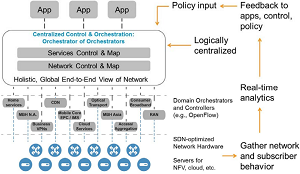News
Firms Fill New-Age Networking Orchestration Gap
New-age technologies such as software-defined networking (SDN) and network functions virtualization (NFV) promise all kinds of benefits -- programmability, agility, lower cost and so on -- but have a lot of moving parts that need to be tied together, which paves the way for the flurry of new orchestration solutions hitting the market.
The latest example: Glue Networks today announced Gluware 2.0, described as "the intelligent orchestration platform designed to unlock the potential of Software-Defined Wide Area Networks (SD-WAN) for enterprise networks and operation teams across the services lifecycle."
By eliminating the need to manually design networks, Glue said its platform frees up skilled workers so they can focus on money-generating projects instead of worrying about the deployment and provisioning of existing software configurations or hardware.
It also reduces network lifecycle costs, the company said, via improved standardization and efficiency, and enhances network agility. "Gluware 2.0 drives business innovation with adaptable network management capabilities and enables network engineers to quickly and easily apply the new policies the business needs, at scale," the company said. "The platform enables network evolution control today and into the future through the gradual migration of existing infrastructure."
SDN/NFV orchestration is also a key topic at the TM Forum Live! conference under way in Nice, France, where Oracle Communications is demonstrating its "next-generation Network-as-a-Service" (NaaS).
 [Click on image for larger view.] The SDN/NFV Architectural Roadmap for 2020 and Beyond (source: Infonetics Research).
[Click on image for larger view.] The SDN/NFV Architectural Roadmap for 2020 and Beyond (source: Infonetics Research).
"Oracle Communications, in collaboration with InfoVista and Juniper Networks, will lead a Catalyst project at TM Forum Live!, 'Zero-Touch Network as a Service: Agile, Assured, and Orchestrated with NFV,' " that addresses the challenge of moving from a static and device-centric networking model to a dynamic, cloud-centric model, the company said in a news release today. Catalyst projects are described as quick proof-of-concept demonstrations.
Oracle will work with InfoVista and Juniper Networks to demonstrate the company's ability to orchestrate business and operational processes along with virtualized network services, the company said.
"The Catalyst also advances industry standards to help communications service providers (CSPs) more easily deploy, operationalize and monetize NaaS," Oracle said. "Specifically, it demonstrates how the full lifecycle of zero-touch orchestration and assurance for NaaS, across an SDN- and NFV-enabled network, maps to TM Forum, MEF and ETSI standards, bridging the work of these industry organizations."
Another company, Netronome, is also taking part in the "Multi-Cloud SDN-NFV Service Orchestration" segment of the French conference. The company, which provides flow processing and other high-performance networking solutions for SDN and NFV, will team up with Microsoft to demonstrate dynamic load balancing over multiple virtual machines (VMs) in multi-cloud deployments.
"This Catalyst project extends the Netronome/Microsoft collaboration from last December's TM Forum to include compute and application scalability performing under advanced SDN-NFV management and orchestration," the Santa Clara, Calif., company said.
"This latest Catalyst project features some of the industry's leading authorities on SDN and NFV and provides a real-world demonstration of Microsoft's site recovery service for cloud infrastructure back-up," the company quoted Microsoft exec Eric Troup as saying. "We're excited to continue our working relationship with Netronome to demonstrate the rapid maturation of SDN and NFV for multi-cloud environments during this pivotal TM Forum Catalyst project."
NFV orchestration is the specialty of yet another Catalyst project participant at the TM Forum Live! conference, MYCOM OSI, which serves the CSP market with service assurance, automation/orchestration and analytics solutions. The company yesterday announced "an NFV solution that automatically directs NFV orchestration actions based on end-to-end service assurance factors, such as faults and QoS degradations, across hybrid, traditional and virtual networks."
"As part of providing closed loop monitoring, analysis and recommendations to the hybrid network managers, MYCOM OSI's solution monitors the performance of the virtual network functions and physical NFV infrastructure they run on and correlates this with the rest of the physical network to provide end-to-end visibility," the company said.
Another NVF orchestration initiative was unveiled less than a month ago by InterCloud Systems Inc., which launched NFVGrid, an NFV orchestration platform.
"InterCloud's NaaS offering (an ETSI NFV ISG framework-based NFV and Cloud orchestration platform) provides multi-vendor cloud and NaaS," the company said. "This new platform utilizes open APIs to ensure interoperability with different OSS/BSS platforms, cloud management systems, SDN controllers and virtualized network function (VNF) managers."
And just a day later, Ciena Corp. announced it was buying SDN/NFV orchestration technology through the acquisition of Cyan Inc. Cyan's "SDN, NFV, and packet-optical solutions deliver orchestration, agility and scale to networks, that until now, have been static and hardware driven," the company said.
All these moves by SDN/NFV players show how vendors are adapting to the new networking world order by filling a management functionality gap, as explained by analyst firm Infonetics Research earlier this year.
"Although the telecom industry is still in the early days of NFV and SDN, we see orchestration technology starting to bloom," Infonetics said in a research report titled "The Evolution of SDN and NFV Orchestration."
"Each NFV use case or SDN network domain requires an orchestration system, and when the operator wants to coordinate two or more domains, a multi-domain or cross-domain orchestration system is required," the report said. "And therein lies the fertile ground for the growth of layers of orchestration systems that will inevitably spring forth to help automate network operation from services to the physical network."
And, just several months later, spring forth they have.
About the Author
David Ramel is an editor and writer at Converge 360.